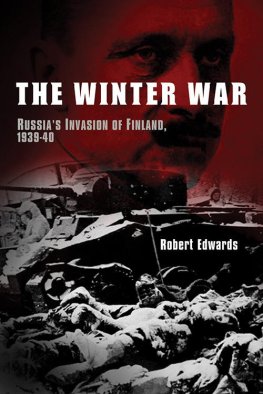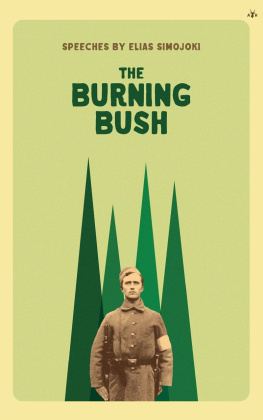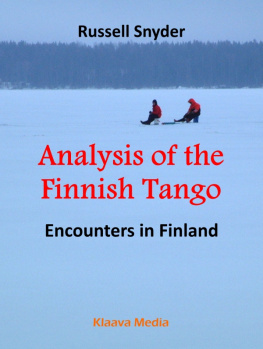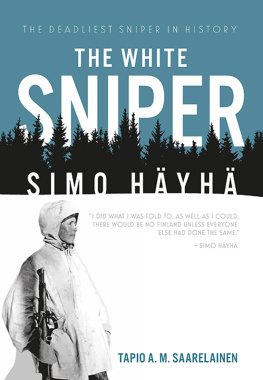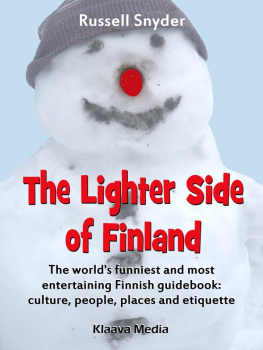Praise for William R. Trotters A Frozen Hell
We will not often find a book written with such authority as this one by Mr. Trotter. We are fortunate to have it. John Eisenhower, The New York Times Book Review
A refreshing look into the Russo-Finnish War. A balanced account that accurately describes the horrifying price both sides were forced to pay. Marine Corps Gazette
Well-researched, eminently readable and valuable to students of military and political history. The Associated Press
A superbly researched and engrossing account. By blending precise descriptions with evocative eyewitness accounts Trotter masterfully recreates all the heroism, tragedy and drama of a campaign whose lessons deserve far more attention. General James R. Galvin, former Supreme Allied Commander, Europe
Mr. Trotter tells brilliantly a piece of history that needed telling. The Washington Times
An immensely readable and thought-provoking book. Army
Trotters account is the best one yet of this unique war. The Virginian-Pilot and Ledger-Star
It will introduce American readers with admirable clarity to battles of which most of us have known almost nothing. Russell Weigley, author of Eisenhowers Generals
The valor of the Finns is known once more. The News & Observer (Raleigh, N.C.)
A vivid account of desperate courage and determination. Contemporary Military Reading List , Department of the Army
A fast-paced and even-handed introductory overview to what is at once both the most tragic and most triumphant moment of Finnish history. The Courier-Journal (Louisville, Ky.)
A FROZEN HELL
The Russo-Finnish Winter War of 19391940
WILLIAM R. TROTTER

Algonquin Books of Chapel Hill
Published by
Algonquin Books of Chapel Hill
Post Office Box 2225
Chapel Hill, North Carolina 27515-2225
a division of
Workman Publishing
225 Varick Street
New York, New York 10014
1991 by William R. Trotter. All rights reserved.
Printed in the United States of America.
LIBRARY OF CONGRESS CATALOGING-IN-PUBLICATION DATA IS AVAILABLE.
E-ISBN 97815651269323
To the memory of Colonel J. N. Pease, whose faith never wavered
CONTENTS
ILLUSTRATIONS
MAPS
ACKNOWLEDGMENTS
This book began as a research project for a seminar course in Russian history at Davidson College, in 196263, and continued as a thesis for a junior-year-abroad program sponsored by the Scandinavian Seminar. Ten drafts and twenty-four years later, the metamorphosis is complete, and my thanks are due to the following people who helped along the way: Mr. and Mrs. Craig Gaskell, for making it possible for me to spend a year in Finland; Dr. A. I. Lobanov-Rostovsky, warrior, scholar, and prince of the Romanov family, for his early encouragement; the late Dr. Halfdan Gregerson, of the Scandinavian Seminar; Mrs. Gunnel Wrede (affectionately known, by members of the Tuborg Gang, as The Baroness); my cohorts in the Tuborg GangRay Myhre, Sara Evans, and Fay Tobias; Mr. Brad Absetz of Viitakivi College, Hauho, Finland, for his valuable aid as a translator and go-between; Mr. and Mrs. Jorma Reinimaa; Reserve Colonel E. Kuusaari, editor of Kansa Taisteli; Eino Nurmio, who was patient and unbelievably helpful during several long months of translation and who became an esteemed friend in the process; Vin Linna, author of Finlands greatest war novel, The Unknown Soldier, who made me welcome in his home and gave valuable insight into the psychology of the Finnish GI; Eila Pekkanen, whose friendship remains a bright and beautiful memory even now; Erkka Maula, poet, philosopher, and sauna-freak, in honor of the hedgehog in the moonlight, the spiritus fortis, and the cause of continual progress; Dr. Louis D. Rubin, whose tough, expert editing made this book finally grow up; and the late Jean Sibelius, whose music ignited my lifelong love affair with the Finnish landscape: all else flowed from that.
AUTHORS NOTE
Place-names in Finnish are quite literal, most often constructed with a suffix that is also a noun, describing exactly what sort of terrain feature is involved. The following place-suffixes are common in this book, and a quick glance at them may help the reader visualize what some of these strange names actually stand for.
-jrvi: lake
-joki: river
-lahti: bay
-niemi: cape
-ranta: beach
-saari: island
-suo: marsh
-vaara: ridge
The Finnish is pronounced like the a in apple.
The abbreviation JR stands for the Finnish term jalkavki rykmentti, which means infantry regiment; 2/JR-16 is the designation for the Second Battalion, Sixteenth Regiment.
PART I
Onslaught and Riposte
When Stalin says dance, a wise man dances.
Nikita S. Khrushchev, in Khrushchev Remembers
CHAPTER 1
The Reasons Why
At the easternmost end of the Baltic Sea, between the Gulf of Finland and the vastness of Lake Ladoga, lies the rugged, narrow Karelian Isthmus. Although the land is sternly beautifulcut laterally by numerous clear blue lakes, tapestried with evergreen forest, and textured by outcroppings of reddish gray graniteit has little intrinsic worth. The soil grows few crops, and those grudgingly, and the scant mineral resources are hardly worth the labor of extraction. Yet there are few comparably small areas of land in all Europe that have been fought over so often and so stubbornly.
The reason is geographic. Since the beginning of European history the Karelian Isthmus has served as a land bridge between the great eastward mass of Russia and Asia and the immense Scandinavian peninsula that opens to the west. The Isthmus has been a highway for tribal migrations, a conduit for trade and cultural exchange, and a springboard for conquest. Armies have washed across itMongol, Teutonic, Swedish, Russianand empires have coveted it, either as a defensive breakwater or a sally port for aggression.
An unopposed army, for example, driving eastward across the Karelian Isthmus from the point where it widens into the Finnish mainland, would be at the city limits of Leningrad in a matter of hours. That is precisely the reason why, in the waning days of 1939, the worlds largest military power launched a colossal attack against one of the worlds smallest nations. Soviet Russia against little Finlandhistory affords few examples of a conflict so overwhelmingly one-sided. And yet, for more than 100 days, Finland waged a David-and-Goliath defensive struggle of unequaled valor and determination, a backs-to-the-wall stand that stirred the hearts of freedom-loving people everywhere and that enabled Finland, though ultimately and inevitably defeated, to remain a free and sovereign nation.
Conflict between Russia and Finland became inevitable in May 1703, when Peter the Great selected a swampy, bug-infested river delta at the eastern tip of the Baltic Sea and proclaimed it the site of his new capital, St. Petersburghis long-sought window to the West. The fact that the land he had chosen, as well as all of Finland to the west of that point, belonged to Sweden did not deter the tsar at all. The annexation of the River Neva delta was just one more move in the power struggle being waged between the Romanov dynasty and the Swedish monarchy; the prize was domination of the Baltic and, with it, lucrative trade routes to the West.
Next page


